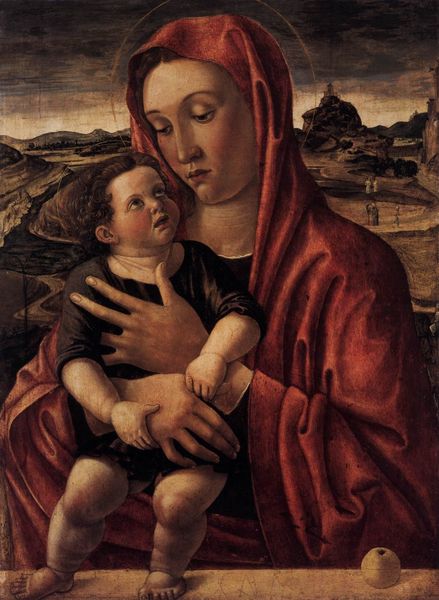
painting, oil-paint
#
portrait
#
high-renaissance
#
painting
#
oil-paint
#
figuration
#
oil painting
#
child
#
christianity
#
portrait drawing
#
history-painting
#
italian-renaissance
#
portrait art
#
fine art portrait
#
christ
Dimensions: 77 x 57 cm
Copyright: Public domain
Editor: This is Giovanni Bellini's "Madonna with Child" from around 1475, painted in oil. It's a tender depiction, but something about the Madonna's robe and the texture of the paint itself catches my eye. What’s most striking to you about this piece? Curator: For me, the interesting aspect lies in how the materiality speaks to production practices. Bellini’s masterful handling of oil paint, itself a relatively new medium at the time, facilitated a richness and depth previously unattainable. Consider how pigments were sourced, ground, and mixed by workshop assistants, reflecting a complex labor system that fueled the artistic production. Editor: That's interesting! I hadn't thought about the division of labor involved. Does the quality of the pigments used reflect anything about patronage? Curator: Absolutely. The vibrancy of the colors suggests the use of expensive pigments, implying a wealthy patron able to afford the best materials. Think about where those materials came from - lapis lazuli for ultramarine, for instance, travelled vast distances. It's about global trade networks influencing even seemingly insular devotional images. Furthermore, the very process of creating oil paint was a skilled craft, involving the knowledge of binding agents and drying techniques. Editor: So, the "Madonna with Child" isn't just an image, it's a product of its time reflecting trade, labor, and craft. Curator: Precisely. By analyzing the materiality, we can decode the intricate social and economic systems embedded within this artwork. The sacred subject meets earthly realities of production. Editor: I’ll definitely look at Renaissance paintings differently now! Considering the pigments and process is eye-opening. Curator: Agreed. Attending to materials lets us engage artworks not merely as aesthetic objects, but as tangible markers of complex historical conditions.
Comments
No comments
Be the first to comment and join the conversation on the ultimate creative platform.













